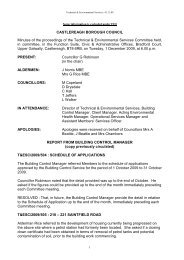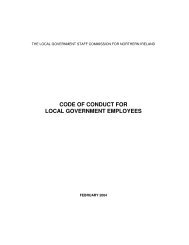MICE MICE - Carrickfergus Borough Council
MICE MICE - Carrickfergus Borough Council
MICE MICE - Carrickfergus Borough Council
You also want an ePaper? Increase the reach of your titles
YUMPU automatically turns print PDFs into web optimized ePapers that Google loves.
<strong>MICE</strong><br />
What do they look like?<br />
The most common mouse found in buildings is the house<br />
mouse, weighing less than 25g. The fur colour varies between<br />
light brown and grey. Body length ranges between 60-90mm<br />
and the tail can add an additional 100mm. Mice have an acute<br />
sense of hearing, frequently using ultrasound to communicate,<br />
and are particularly sensitive to any sudden noise.<br />
Where do they live?<br />
Mice live in nests that they build out of cloth, wool and paper.<br />
Nests are often built inside houses, in places such as roof<br />
spaces, under floors or in wall cavities, and wherever there is<br />
access to a good source of food, especially during the winter.<br />
Mice can squeeze through cracks as small as 5mm but mouse<br />
holes are normally 20-30mm in diameter. Mice are mainly<br />
active at night and can often be heard running about as they<br />
search for food.<br />
What do they eat?<br />
Their favourite foods are cereal products, although they<br />
will eat almost anything. Most of the damage they do is by<br />
gnawing and ripping open packets. They also spoil food with<br />
urine and droppings. Mice will gnaw their way through wood<br />
to get to sources of food.<br />
The <strong>Council</strong> provides information leaflets on the<br />
following range of pests:<br />
Ants<br />
Bedbugs<br />
Cockroaches<br />
Fleas<br />
Flies<br />
Mice<br />
Pigeons<br />
Rats<br />
Slugs<br />
Spiders<br />
Wasps<br />
Pest Control Advice<br />
<strong>MICE</strong>
What are the signs of infestation?<br />
There are a number of signs to look out for and if found, may<br />
indicate mouse activity.<br />
Mice droppings<br />
Droppings are often black, rod shaped and 3-6mm long.<br />
Fresh droppings will be soft and moist. Each mouse can leave<br />
approximately 80 droppings per day. Common places to find<br />
mouse droppings are under the kitchen sink, around central<br />
heating boilers and in roof spaces.<br />
Smears<br />
These are dark grey marks left on surfaces by repeated contact<br />
with the oils in mouse fur.<br />
Nests<br />
Sometimes nests can be found indoors for example in lofts,<br />
under floorboards or in airing cupboards.<br />
Gnawing<br />
Mice gnaw continually on materials such as wood, carpets,<br />
paper, pipe cables and furniture. Check for damage to<br />
foodstuffs in cupboards.<br />
Why must mice be controlled?<br />
In addition to the damage caused through gnawing, mice have<br />
been known to spread diseases such as salmonella and listeria,<br />
which lead to food poisoning and stomach upsets.<br />
How can I prevent mouse infestation?<br />
Householders can assist in preventing mouse infestation by<br />
taking a number of simple precautions.<br />
- Do not leave household waste where mice can get access<br />
to it, close dustbin lids and composters and do not feed<br />
wild birds to excess - you may be feeding mice as well.<br />
How can I get rid of mice?<br />
It is important to get rid of mice quickly, as house mice<br />
reproduce rapidly. It is possible to carry this work out<br />
yourself however, a professional pest control expert<br />
will always have more technical expertise and access to<br />
rodenticides that are not available over the counter.<br />
If you decide to carry out the work yourself there are two<br />
options, – poison or break-back traps.<br />
Mouse poison (rodenticide) can be bought from most<br />
hardware stores and most garden centres. Put the poison in<br />
a safe and secure place out of reach of children and pets and<br />
ALWAYS wash your hands after use. Rodenticide can take<br />
4-12 days to take effect. This may result in a localised foul<br />
smell due to the presence of carcasses.<br />
Break-back traps may be set and these should be placed<br />
next to walls where mice tend to travel. The trap should be<br />
baited with chocolate, biscuit or cereal. Use several traps<br />
and examine them daily, removing dead mice as soon as<br />
they are discovered. All traps should be handled with care.<br />
Seek professional advice from the <strong>Council</strong>’s Environmental<br />
Health Service if you require any assistance.<br />
Warning: When using pesticides always follow the<br />
instructions on the label. Remember that pesticides may<br />
be harmful to other animals e.g. household pets etc.<br />
- Keep your home in good repair. Mice only need a gap the<br />
diameter of a pencil to gain entry.<br />
- Remove potential nesting sites by keeping yards and gardens<br />
clean and tidy, and by cutting back overgrown areas.<br />
- Seal gaps around heating and water pipes.<br />
- Ventilation bricks and slots should already have a fine wire<br />
mesh incorporated. If this is worn, replace it externally with<br />
3.15mm insect mesh.
















